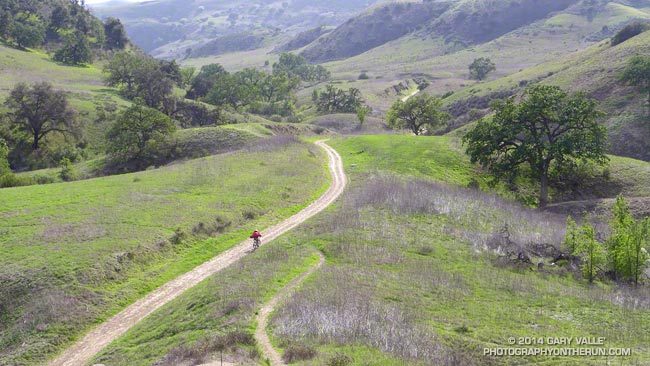
A spectacular Spring day for a run or a ride!

A spectacular Spring day for a run or a ride!
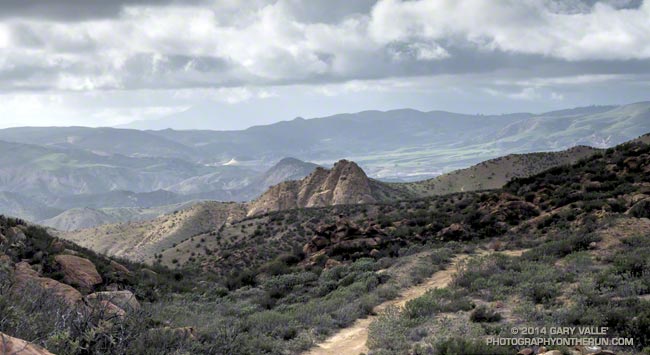
There seems to have been a change to a more seasonable weather pattern in California. It looks like Spring weather will prevail over the next week or so, with some opportunities for showers or a little rain in Southern California and more significant amounts of precipitation in Central and Northern California.
Even if it was a little cool and blustery, the unsettled weather was perfect for today’s run on the Chumash Trail and Rocky Peak Road!
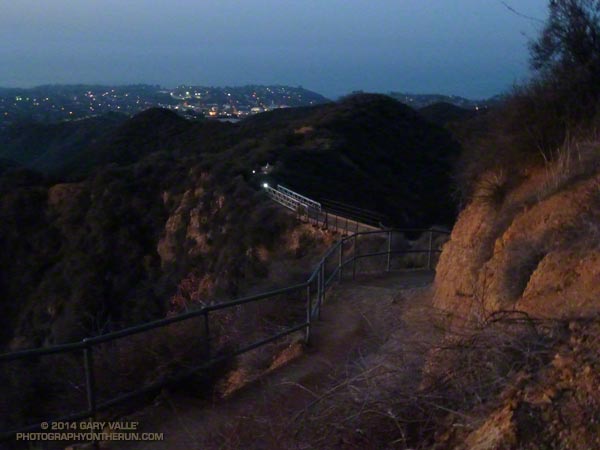
Runners on the Backbone Trail at About Mile 2 of the Backbone Ultra
Last year I ran the Coyote Backbone Trail Ultra and enjoyed everything about it — the trails and scenery, the runners, the volunteers, the approach of the organizers, and just the general vibe of the event. The Backbone Ultra team did a superb job, and as far as I know there no major issues. Nobody got lost or seriously injured. The runners and volunteers were respectful to the environment and everyone I talked to had a great time participating in the event.
Still I wondered. Because of its complex logistics and administrative requirements would there be a 2nd annual Backbone Trail Ultra? Then on August 22, a little after lunchtime, the news was posted — there would be a “Game 2!” I needn’t have worried, RDs Howard Cohen and Mike Epler were on it!
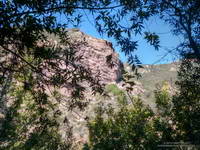
On March 15 at 6:07 a.m., at Will Rogers State Park, under the light of a 99% full moon, myself and 46 other runners in the first start group began our Backbone Trail adventure.
In the weeks leading up to the Backbone Ultra I’d been closely watching the weather. Two weeks prior to the run the area was inundated by the most rain in 48 hours since 2011. There had been some concern that heavy rainfall in the Springs Fire burn area in Pt. Mugu State Park would severely damage trails. That didn’t happen.
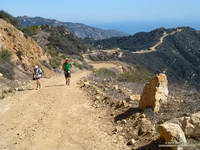
Ten days out it looked like an upper level low might affect the area. That didn’t happen. As the event neared, the forecast trended drier and warmer — much warmer. Friday as I was getting my drop bag ready, @NWSLosAngeles tweeted “Still expecting high temps to approach records at some locations this weekend” along with this graphic. That did happen!
On Saturday, the first day of the event, Santa Ana winds pushed the temperature at noon at Malibu & Piuma to 86 degrees — 16 degrees higher than during last year’s event! Note that this is the temperature in a ventilated, white-painted box several feet off the ground. The “in the sun” temperature, near the ground, on south-facing slopes was likely in the 90’s. Even more telling, the temperature at Circle X was in the 80’s from noon until 5:00 p.m. and at midnight was 74 degrees!
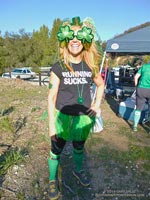
It must have been something to be on the Backbone Trail at its highpoint near Sandstone Peak in the middle of the night, with 100 mile visibility, a full moon and warm weather. I am really bummed to have missed that! I didn’t get to experience it because I had some kind of heat-related issue and dropped at the Encinal Aid Station at around mile 43.
This is the first time heat has kept me from completing a run or race. So what was the problem? Probably a combination of things. I don’t think I was under-trained or over-trained. I hadn’t just had the flu or a cold. My taper seemed OK. It wasn’t under-hydration, at least not in the first 30 miles. My best guess is that anticipating the heat, I drank too much early on. Not having trained much in the heat this year probably also contributed. It’s hard to know for sure. Sometimes it’s just not your day!
Although I didn’t get to the finish this year, I still very much enjoyed the miles I did run on the Backbone Trail. Here’s a slideshow of some images taken along the way.
It is a tribute to the many people that helped support the Backbone Trail Ultra that — by a substantial margin — there were more volunteers than runners! Many thanks to:
– RDs Howard Cohen & Mike Epler and their team Fred & Lauren Case, Willie Roland, Tres Smith, Erica Gratton and Dan Dicke.
– California State Parks and the National Park Service.
– Trippet Aid: Rene Canizales and the New Basin Blues.
– Stunt Aid: Alison Chavez/Amy Chavez and the SoCal Coyotes.
– Piuma Aid: Art Byrne and the Trail Runners Club.
– Corral Aid: George Plomarity and Patagonia.
– Kanan Aid: Paul Van Zuyle and his leprechauns.
– Encinal Aid: Bill Kee and wife Paula and the Coyote Cohorts.
– Mishe Mokwa Aid: Manley Klassen and wife Mara and the Coyote Cohorts.
– Sycamore Aid: Puerto Mauricio and the Coyote Cohorts.
– Finish: Erica Gratton & Janna Williams and the Conejo Valley Trail Runners.
– Breakfast: Luis Escobar, Jerry Gonzales and team.
– Medical: The Josepho Team and Ventura County Search and Rescue.
– HAM radio operators at each of the aid stations and the finish.
– Volunteers at the road crossings at Stunt, Piuma, Malibu Canyon, Latigo Canyon, Encinal Canyon, Mulholland Highway and Yerba Buena times 2.
– Sweeps: Kathy Higgins, Rene Canizales, Erin Chavin & Pedro Martinez, Ken Hughes and Jack Fierstadt.
– All the Course Markers & Safety Patrols.
Some related posts: Backbone Training Run 2014 #1, Backbone Training Run 2014 #2, Run, Lop and Shiver, Backbone Ultra 2013
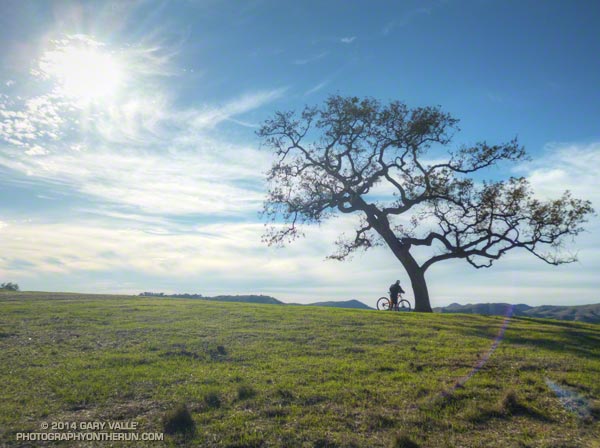
The Mortar Pothole
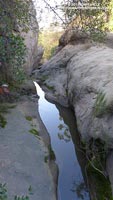
The “Mortar Pothole” is a water feature in the Simi Hills I’ve been monitoring on runs for more than 13 years. Its likeness to a mud puddle is deceiving; it typically has water from October or November into August — a period of 9 to 10 months!
I’ve never seen the Pothole dry in the middle of a rain season, even during 2006-07, the driest water year on record in Los Angeles. But on February 17, 2014, following a 10 month period in which Los Angeles received only 1.2 inches of rain, the Pothole was dry and would remain dry until recharged by the 4+ inches of rain the area received from February 26 to March 2.
Now that the Pothole has been refilled and its groundwater sources at least partially replenished, water should persist in it well into Summer.
Ahmanson Blue Oak
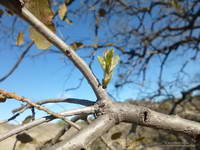
Because I’ve been doing longer weekday runs I had not run past the blue oak at Ahmanson Ranch in a few months. Located north of Lasky Mesa, the tree may be one of the southernmost blue oaks in California. Regional climate modeling suggests that over the next century the range of blue oak may shift northward and diminish to nearly 60% of its current range, making the Ahmanson blue oak a potentially important bellwether of climate change.
After the recent rainfall I happen to run by the blue oak. Still in Winter dormancy, the tree had dropped many of its leaves and looked threadbare. Valley oaks in the area already had a flush of new, green leaves. Although the blue oak is very drought tolerant I wondered if the long period of dry weather might have claimed another victim.
A closer look at the blue oak’s limbs on another run revealed tiny leaf buds, and some sprouting leaves. That was a relief — the Ahmanson blue oak appears to be surviving the drought and will soon sport a new suit of leaves!
I checked on the blue oak on March 24th and its flush of new leaves were coming along nicely. This natural cistern, in the same drainage as the blue oak, still had water on March 18th.
Las Virgenes Creek
Even before our recent storms, small pools of standing water had developed in a few places along Las Virgenes Creek in Upper Las Virgenes Canyon. There are a number of springs along the creek and perhaps the suppression of plant growth by the drought and lower Winter evaporation rates created the pools.
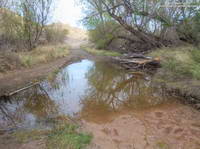
From late Thursday (Feb 27) until late Saturday (Mar 1), the Cheeseboro Remote Automated Weather Station, located on a ridge on the west side of the canyon, recorded 4.26 inches of rain.
Surprisingly, the pools and the creek didn’t look much different before and after the rain, and there was no evidence of surface water flow in the creek bed at the crossing just north of the Cheeseboro connector. The drainage above this point, dessicated by months of drought, absorbed many millions of gallons of rainfall!
This was not the case for all small creeks. Garapito Creek in Topanga State Park appears to have flowed for a period during the storm, but only puddles remained in the creek bed on Sunday, March 2.
Some larger local creeks peaked at flows not observed since March 2011. According to preliminary USGS data Sespe Creek at Fillmore peaked at 6,180 cfs and Calleguas Creek near Camarillo peaked at 2,970 cfs.
One thing that was very different at Las Virgenes Creek following the rain was the dramatic increase in the number of calling chorus frogs.
Rocky Peak Vernal Pools
The vernal pools on Rocky Peak are another water feature I’ve monitored for many years. They result from small scale aquifers in the sandy soil becoming saturated and occur during most rain seasons with normal rainfall. I have not had a chance to check them yet, but suspect that as in the case of Upper Las Virgenes Creek, most of the rainfall was absorbed by the very dry soil.
On March 19th I checked a group of vernal pools on Rocky Peak. One of the larger pools did contain some water. Based on the recession rings around the pool, it was being quickly absorbed. A week later, March 26th, I checked a pool in another area of Rocky Peak and found that it had recently contained a little water, but none remained.
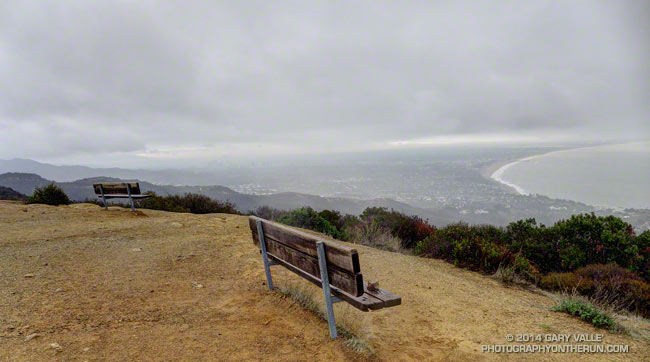
Beginning Wednesday evening and continuing into Sunday, two Pacific storm systems ended a nearly 14 month period of record-setting dry weather in Los Angeles and much of Southern California. Los Angeles experienced the driest calendar year on record in 2013, and until Friday had received less water year rainfall (since July 1) than in 2006-07, the driest water year since recordkeeping began in 1877.
According to preliminary precipitation data, Downtown Los Angeles (USC) recorded 4.52 inches of rain over the course of the storms, increasing its water year total from a desiccated 11% of normal to a not-too-bad-considering 50% of normal. Downtown Los Angeles’ water year rain total now stands at 5.72 inches. This exceeds last year’s cumulative precipitation total on this date by more than an inch, but still leaves us with deficit of nearly six inches.
Friday’s rainfall total of 2.24 inches was the most recorded in 24 hours at Downtown Los Angeles since March 20, 2011, and Thursday’s and Friday’s total of 3.29 inches was the most rain recorded in 48 hours at Downtown Los Angeles since December 19 & 20, 2010. The storms increased February’s rainfall total to near normal, and jump-started March with nearly half its normal amount of rain.
Foothill and mountain areas that faced into the storms’ moist southerly flow recorded some impressive rainfall totals. According to this compilation of preliminary rainfall totals from the NWS Los Angeles/Oxnard, Opids Camp near Mt. Wilson recorded nearly 11 inches of rain, and several stations in the Ventura Mountains recorded double-digit rainfall totals.
Update March 4. With this recent rainfall 2013-14 will not be the driest water year in Los Angeles on record; but one good storm, or even two, “does not a rain season make.” In the short term these storms have dramatically reduced the fire danger, provided crucial relief to plants and animals, and increased groundwater and reservoir storage. What happens in the longer term we’ll just have to see. Over the next several days a series of systems are forecast to produce additional rain from Central California north into the PNW. While no rain is forecast in Southern California over the next week or so, and the 8-14 day outlook is for below average rainfall, some model runs have indicated the possibility of additional rain around mid-month. As long as the Pacific weather pattern remains progressive there should be additional opportunities for rain in the weeks ahead.
A related post with more technical detail and graphics is available on my weather and climate web site Southern California Weather Notes.
The title photo is from yesterday’s showery run to Parker Mesa in Topanga State Park.
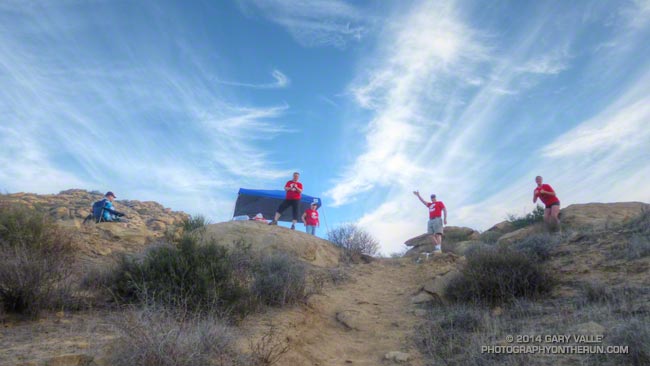
As I worked up the hill toward “Fossil Point” I drank the last mouthful of water from my bottle. I wasn’t surprised that I had run out. The morning temperature had been the warmest in the six year history of the event, and the midday temp in the sun felt like it was in the mid-80’s — maybe higher.
In Southern California it has been the kind of Winter that those in northern climes can only dream about: Day after day with fair skies and the temperature in the 70’s and 80’s. Great for trail running, but with the trade-off that we had had the least amount of rain in over a century.
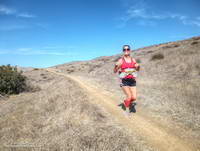
Chugging up the steep hill I thought about how the run had gone so far. Even if it was a little warm, it was still a pretty good day for a trail run! I hadn’t tried to push the pace on the initial steep climb from Corriganville, and had (mostly) resisted the temptation to pound down the Chumash Trail. The crazy-steep section of Hot Dog Hill on the out and back section of the course felt just as steep and insane as it did last year and the downhill to the Open Space aid station just as pleasant.
It was awe-inspiring to see the faster runners as they returned from Tapo Canyon. As I started the descent into Chivo Canyon Jay Bonthius, the eventual winner of the 50K, had flashed past. The youngest runner in the race, the 19 year old went on to finish his first 50K in 4:05:52 — setting a new course record. His average pace was a remarkable 7:55 min/mile! He ran up the hills faster than many of us ran down them!
I was very happy to get to the top of the climb at Fossil Point. Although it wasn’t the end of the running, or the hills, it was a key point in the 50K. It marked the end of a grueling 5 mile climb from the Las Llajas aid station — the last major climb on the course. It also had water.
I had carried two bottles and that was still not quite enough. There is only so much time during a race available for hydration, and I had made the mistake of not drinking water early, BEFORE I was thirsty. At this point I was dehydrated and that could not be completely remedied until sometime after I crossed the finish line.
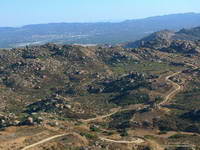
Another four miles would find me at the top of the Corridor Trail, which on tired legs might as well be the edge of the earth. This steep one mile descent is the most technical on the course and as challenging as any of the hills. I am always happy to get to the bottom. From here the finish is a little more than a half-mile away and I smiled as I heard the cheers as another runner crossed the finish line.
More than 500 runners participated in the 6th edition of the Bandit Trail Runs, competing at distances that ranged from 6K up to 50K. Many thanks to Bandit Race Committee – RD Randy Shoemaker, Sarita Shoemaker, Eric Cartier, Tommi Diaz, Mat Diaz and Josh Lewis. Each year they find a way to make an outstanding event even better!
Once again the aid station volunteers were phenomenal! Thank you Nancy Shura-Dervin and the Ultraladies, the Encino Trail Heads, Sue Apostolof, Diane Treptows, and all the volunteers! There was not an aid station where I wasn’t greeted with a smile and all the help I needed. Also many thanks to those that worked registration, parking, the finish line, timing, finish line food, photography, safety, communications, and all the other work needed to put on an event like the Bandit.
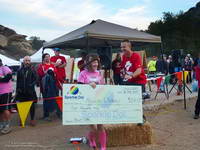
Reflecting the dedication and character of its organizers, each year the Bandit gives back by supporting an important cause. Last year Bandit raised funds for a local high school running program. This year Bandit is rallying behind runner Alison Chavez in her battle against cancer.
Here is a slideshow with a few images from this year’s 50K.
(The Bandit Trail Runs are now the Rocky Peak Trails races.)